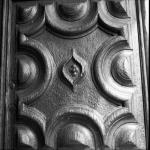|
Certex Indiana Jones |
Manufactured or assembled in Spain from 1987 to (After) 1987.
Index of rarity in France: Rare (among non-specialized garage sales)
Inventory number: 10573
See the complete technical specifications
Chronology of cameras Certex
In the 1940s, the company Pawsa (Pablo A. Wehrli S.A.), owned by Pablo Adrian Wehrli Wild, imported and distributed photographic products.
 Due to the limited volume and value of the Spanish market and the country's political isolation, the imported equipment was of medium quality. In 1952, Pawsa made the decision to manufacture photographic equipment in Barcelona by creating the company Certex. In 1953 and 1954, Certex manufactured Daci and Digna cameras using imported spare parts. Certex expanded, and in 1960, the first camera entirely manufactured in Spain, the Wesa I, was introduced.
Due to the limited volume and value of the Spanish market and the country's political isolation, the imported equipment was of medium quality. In 1952, Pawsa made the decision to manufacture photographic equipment in Barcelona by creating the company Certex. In 1953 and 1954, Certex manufactured Daci and Digna cameras using imported spare parts. Certex expanded, and in 1960, the first camera entirely manufactured in Spain, the Wesa I, was introduced.
During the 1960s, a particularly favorable fiscal policy for Spanish companies led to the gradual disappearance of competitors, which were considered mere subsidiaries of foreign companies. Improved productivity and cost reduction led Agfa to sign a subcontracting contract with Certex during the 1970s.
The first generation has the main body in black color, the sole and the bonnet in metallic. The front face of the hood has an extra thickness including the viewfinder window, the useless central window and the marking giving the name of the model. This one is in black and red. On the first copies, it is partially engraved. Subsequently, it will simply be screen printed on an insert. These early copies have a trigger button resembling Agfa's Sensor. It will quickly be replaced by a metallic button avoiding confusion. The lens is a Certar 7.5 / 38mm. The shutter has three speeds, represented by pictograms. There is no ring to hang a strap. Around the front lens, there is the name of the lens, its focal length and its maximum aperture.
The front of the top cover of the second generation, 1979, is different. The model name is no longer inside the allowance. The trigger button is green. A strap ring appears. The inscriptions around the lens remain. There are copies of this generation with the hood and sole in black color.
The third generation, from 1981, can be recognized by the change in registration around the lens. The maximum aperture number disappears. Often black with a green shutter button, this model is often confused with the black models of the second generation. You have to pay attention to the lens markings to distinguish them.
The camera of this generation were sold as a kit, accompanied by a flash.
The fourth generation (1985) is easily recognized by the bright colors of the front part of the body. __________
In 1987, things were not going well for Certex. Their cameras were outdated, and the Asian competition was unbeatable. By taking over the second-generation Werlisa Club Color cameras and signing a merchandising contract to use the names and visuals from the Indiana Jones film series, Certex attempted to make a comeback.
The model is sand-colored. A sticker with the character's name is placed on the hood, while another one with a photo of Indiana Jones1 is attached to the camera body. The shutter button and the marking on the lens are green. The camera, sold individually or in a Safari kit, was launched at Christmas 1987 with a lot of advertising. Unfortunately, it was a failure.
1 The visual is taken from the poster of Indiana Jones and the Temple of Doom, released in 1984. One might be surprised by the gap between the release of the camera and the last film in the series. The next film, Indiana Jones and the Last Crusade, would not be released until 1989.


Interesting links or bibliography :
Add a link or element of bibliography, a picture taken with this camera, a picture of box or an ads about this camera
Your photos taken with the same camera:
Cameras from Ebay France (Certex) (Uploaded each 3 hours)








